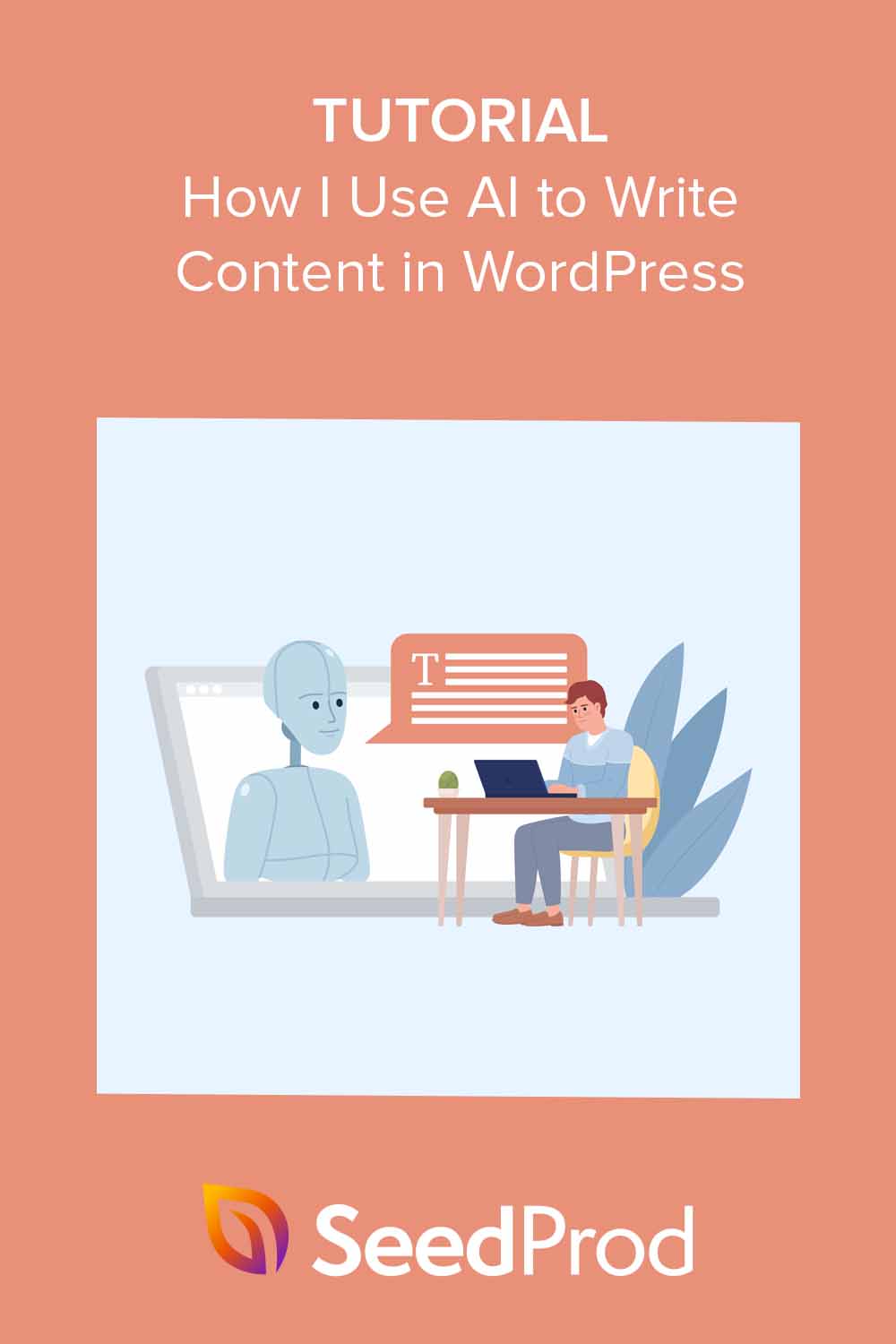I’ve been a content creator for 10+ years, and even after all that time, I still need help finding ideas and the right words to make my content stand out. The process of creating high-quality content is time-consuming and hard work.
When I first heard about AI writing tools, I was skeptical. Can they really help me write faster? Will they be able to meet my high-quality writing standards?
So, I decided to try over a dozen AI content writing tools to see if they lived up to the hype. While most tools didn’t, some really surprised me. Now, I’m using AI tools daily to create all types of content, from blog posts to emails.
In this guide, my goal is to share my experience with AI writing tools, highlighting the good and the bad and sharing tips I’ve picked up to improve my writing workflow.
Table of Contents
Why I Use AI for Content Creation
As I mentioned, content creation wasn’t always easy for me. I often struggled with writer’s block. Researching topics took time, and even then, I sometimes felt like my writing was bland and uninspired.
That’s when I learned about AI writing tools. The idea of using artificial intelligence algorithms to help me as a content writer was both fascinating and a little intimidating. Could a machine really help me overcome my writing challenges?
I was skeptical at first but also curious. So, I gave it a try, hoping that AI writing software could help me save time, generate new ideas, and improve the quality of my content.
My Favorite AI Writing Tools and How I Use Them
I’ve tried dozens of AI writing tools, and I’ve found three that stand out for my content creation needs.
1. SeedProd

SeedProd, the best WordPress website builder, is my go-to for website and landing page copywriting. It’s a drag-and-drop plugin that allows you to create professional-looking websites without any coding knowledge.
The built-in AI writing assistant, powered by OpenAI, helps me generate headlines, calls to action, and other persuasive copy elements that drive conversions.
2. ChatGPT

When I’m stuck on ideas or need help researching a topic, ChatGPT from OpenAI is my trusty sidekick. It’s a large language model trained on a massive dataset of text and code.
I can conversationally interact with ChatGPT, asking questions and getting answers. I use it to brainstorm blog post topics, outline content, summarize long-form content, generate use cases, and even get answers to questions I have about a subject.
3. Gemini

This generative AI chatbot from Google is a workhorse for my everyday content needs. It uses a combination of natural language processing and machine learning to generate text, translate languages, write different kinds of creative content, and answer your questions in an informative way.
I use Gemini to write blog posts, emails, social media posts, marketing copy, and even product descriptions. It’s incredibly helpful for generating drafts, understanding my brand’s voice, and overcoming writer’s block.
Of course, there are many other great AI content generators out there, such as Jasper AI, Copy.ai, and Claude, just to name a few. I encourage you to experiment and find the best AI writer that works for you.
How I Use AI to Write Content for Web Pages
SeedProd is a WordPress plugin I use daily to manage this website and build landing pages. Its drag-and-drop builder is already a game-changer for no-code design, but with its AI assistant, creating professional web pages is faster and easier.
Before I explain how to use it, check out my guides on creating a landing page and building a custom WordPress theme with SeedProd. They’ll show you how the drag-and-drop editor works and how easy it is to create a WordPress website without hiring a developer.
Now, let’s look at how I use SeedProd’s writing assistant to streamline my workflow.
Selecting Text to Edit with AI
Start by editing any of the pages you’ve created with SeedProd. For this guide, I’ll edit my homepage template.

Once you’re inside the page builder, select any text block, such as a heading or description. You’ll then see a panel in the left-hand sidebar where you can type new content and adjust the text size, link, and more.

You’ll also see an “Edit with AI” button, so go ahead and click this.
Clicking the button reveals a popup window with several AI settings.
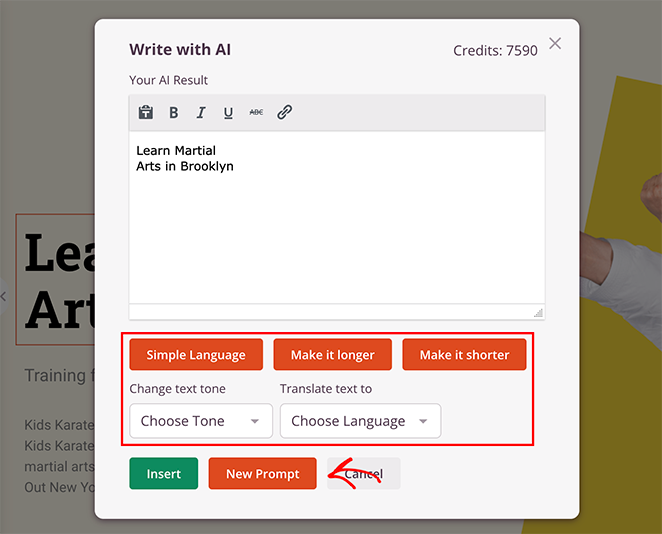
Here, you can edit your existing text with AI. For example, you can simplify the language, make it shorter, or make it longer. There’s also the option to change the tone of voice and language.
Since we want a new headline, let’s click the “New Prompt” button.
Generating a New Prompt
In the new prompt window, you can choose a suggested prompt or write one yourself in the text box.
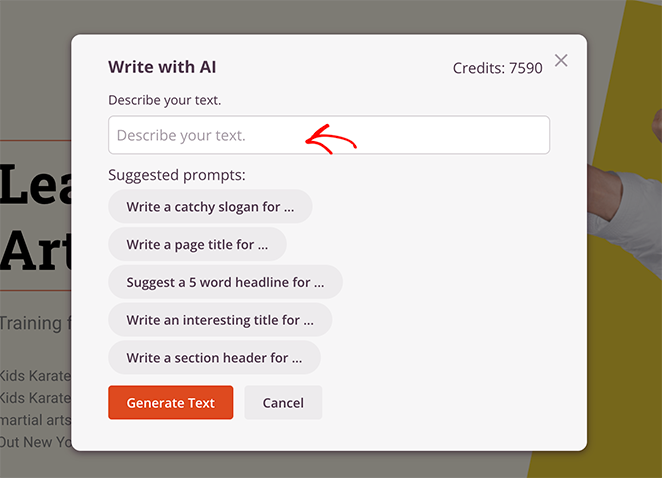
For this page, I want to educate visitors about Karate classes in my local area. So, I’ll type the following prompt:
“Write a short, catchy page title for Karate Classes in NYC.”

Then click the “Generate Text” button.
The AI assistant generates the headline in seconds. From there, you can refine it using one of the editing options or click the “Insert” button to add it to the page.
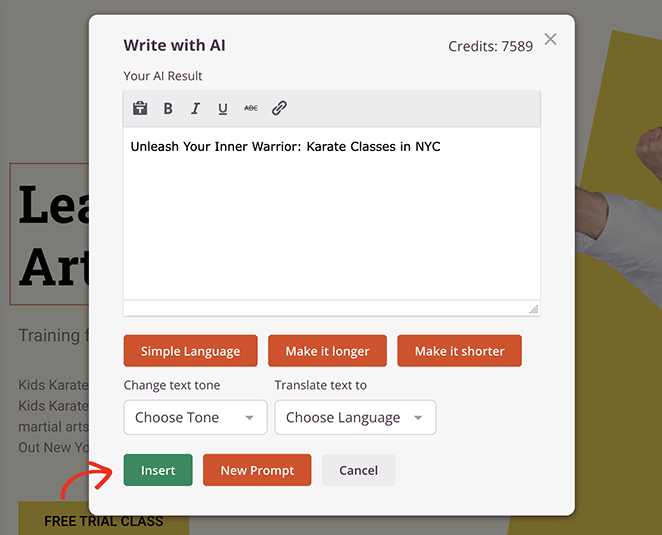
Now, let’s repeat the process to generate a more compelling intro for the page. Like before, select a text element, click the “Edit with AI” button, select the “New Prompt” button, and enter your instructions.
The prompt I’ll use for this section is:
“Write a short engaging description about Kids Karate after school classes in NYC.”
This time, the generated text is too wordy, so I’ll click the “Make it Shorter” option.

Now, the text is ready to insert into the page.

Continue like this to create content for your web pages. When you’re happy with the results, save and publish your page.
Here’s a final look at my final page:

My Results with SeedProd
Since adding SeedProd’s AI assistant into my workflow, I’ve noticed an improvement in both the speed and quality of my web page creation process. I can now produce compelling website and landing page copy in a fraction of the time it used to take me.
Want to create a similar page?
How I Use AI to Brainstorm Content Ideas
I’ve always found coming up with fresh ideas one of the hardest parts of content creation. But ChatGPT has quickly become my brainstorming buddy, helping me break through writer’s block and discover new angles for my content.
Before I explain how I use it, let’s define ChatGPT. It’s a large language model developed by OpenAI. In simple terms, it’s like having a conversation with a computer that’s read a lot of books and articles.
So, how do I use it? Let me walk you through my AI content creation process with ChatGPT step-by-step.
Chatting with ChatGPT
To start, go to the ChatGPT website and create an account. Once you’re signed in, you’ll see a chatbox where you can begin typing.

Think of it like a text message conversation. You type a message, hit enter, and ChatGPT responds. You can type anything you want, but to get the most out of it, try asking specific questions or giving it prompts.
Here are some examples of prompts I’ve used to generate ideas:
- “Give me 10 blog post ideas about content marketing”
- “I’m writing an article about content marketing. Here is my keyword research [paste keywords]. Can you help me brainstorm some interesting subtopics?”
- “Research the most important facts about content marketing my audience might want to know.”

The more specific your prompts are, the better the results will be.
Refining the Results
ChatGPT will generate a response to your prompt. Sometimes, the ideas are great, and other times, they need tweaking. That’s where your creativity comes in.
Look through the suggestions and see if any spark your interest. If not, try rephrasing your prompt or asking a follow-up question.
For example, if you asked for blog post ideas and aren’t happy with the results, you could say:
- “Can you give me some more ideas that are specifically for my target audience: beginners?”
- “I’m looking for ideas that are more focused on SEO.”
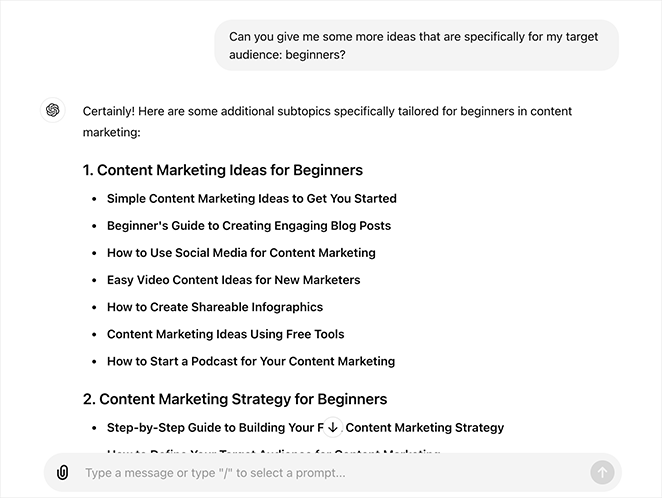
Keep refining your prompts until you get ideas that you’re excited about.
Putting It Into Action
Once you have a few ideas that you like, it’s time to start writing. ChatGPT can help you outline your content, write the first draft, or even edit and proofread your work.
Here’s the prompt I’d use to write a content outline:
“I’m writing an article about [paste your title]. Here is a list of subtopic ideas for my article [paste subtopic ideas]. The keyword for this article is [paste your keyword here]. Please turn this research into a complete SEO content outline.”
And here is what ChatGPT generated:

My Results with ChatGPT
Using ChatGPT has transformed my brainstorming process. It helps me generate more ideas in less time, and the quality of my content has improved.
But remember, ChatGPT isn’t a replacement for your creativity and expertise. For instance, I have to fact-check statistics, and I’ve found it doesn’t always provide the most up-to-date information. That’s where human writers are invaluable.
How I Use AI to Write Blog Content
Creating engaging blog content is challenging, but Gemini, Google’s AI chatbot, has revolutionized my writing process. It’s like having a writing partner who’s always available, full of ideas, and ready to help me craft compelling content.
Not familiar with Gemini? It’s Google’s conversational AI, designed to engage in natural-sounding dialogue. It’s still in its early stages, but I’ve found it incredibly helpful for generating blog post drafts and refining my writing.
Let me show you how I use it.
Starting a Conversation with Gemini
To get started, head over to the Gemini interface (you can sign up with your existing Gmail account). Once you’re in, you’ll see a chat box where you can start typing.

Think of it like a conversation with a friend. You can ask questions, make requests, or just start typing your thoughts.
For example, I might start by saying:
- “I need help writing a blog post about the benefits of using AI for content creation.”
- “Can you help me brainstorm some catchy ad copy examples about WordPress SEO?”
- “I have a draft of a blog post. Can you help me improve its readability and make it sound more engaging?”
Gemini will respond with suggestions, ideas, or even a full draft of your content.
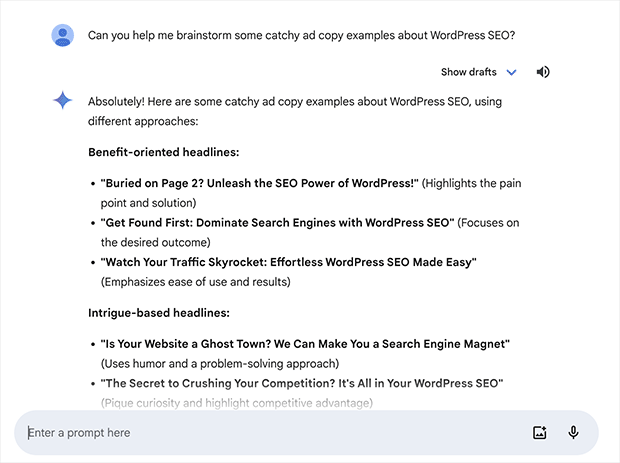
Collaborating with Gemini
The beauty of Gemini is that it’s a collaborative tool. You can work with it back and forth, refining your ideas and improving your writing.
For example, if Gemini generates a draft that’s not quite right, you can tell it:
- “Can you make this more concise?”
- “Can you add some examples?”
- “Can you make this more persuasive?”
Gemini will take your feedback and generate a revised version of the content. This back-and-forth process allows you to create high-quality blog posts quickly and easily.

You can even highlight parts of the generated text and right click to select quick modifications, which saves you from writing everything out all over again.

My Results with Gemini
Since I started using Gemini, I’ve noticed a significant improvement in my writing speed and quality. I can now produce blog posts in a fraction of the time it used to take me. Plus, thanks to Gemini’s suggestions and insights, my content is more engaging and informative.
Of course, like any AI tool, Gemini isn’t perfect. It sometimes generates content that needs to be edited or refined. But overall, it’s been an invaluable tool for my blog writing process.
Tips for Editing Your AI-Generated Content
While AI can generate impressive content, it’s important to remember that it’s not perfect.
Here are my top tips for editing your AI-generated content to ensure it’s accurate, engaging, and reflects your unique voice:
- Fact-check everything: AI tools can sometimes produce inaccurate information, so it’s crucial to verify any facts, figures, or claims made in the content.
- Add your personal touch: Inject your personality, opinions, and experiences into the writing. This will help your content stand out and connect with your audience on a deeper level.
- Ensure it’s SEO-optimized: While AI can help with keyword placement, it’s important to ensure your content is optimized for search engines. This includes adding meta descriptions, alt text to images, and internal links.
- Proofread carefully: AI tools can make grammatical errors or produce awkward phrasing and formatting. Always proofread your content carefully to catch any mistakes and ensure it reads smoothly.
- Add Visuals: Break up your text with relevant images, infographics, or videos. You can use AI image generation tools to create custom visuals or source high-quality stock photos.
- Incorporate FAQs: Anticipate and answer common questions your audience might have about the topic. This provides valuable information and can improve your website’s SEO.
- Link Strategically: Include internal links (to other relevant pages on your site) and external links (to reputable sources) to enhance the user experience and provide additional context.
Benefits and Challenges of Using AI to Write Content
Including AI in my content creation process has been transformative with several clear benefits:
- Increased Productivity: AI tools help me generate ideas, write drafts, and edit content faster, freeing up time for other tasks.
- Improved Quality: AI assistants suggest alternative phrasing, identify errors, and offer structural insights, improving my writing quality.
- Enhanced Creativity: Brainstorming with AI sparks unexpected ideas and pushes me beyond my usual writing patterns.
However, using AI isn’t without challenges:
- Maintaining a Human Touch: AI-generated text can lack nuance and personal touch. I always review and edit to ensure authenticity.
- Ensuring Accuracy: AI can sometimes be inaccurate. I double-check facts and never rely solely on AI for research.
- Ethical Considerations: It’s important to use AI responsibly. I always use a plagiarism checker to ensure I’m not copying anyone else’s content.
By being mindful of these challenges, I can use AI while maintaining the quality and integrity of my content.
FAQs About Using AI to Write Content
Yes! It’s legal to use AI writing tools, but it’s important to use them responsibly and ethically, ensuring the content you produce is original and properly attributed.
While AI is a powerful tool, it’s unlikely to replace content writers entirely. AI can help with tasks like generating ideas and drafts, but human writers are still essential for creativity, critical thinking, and adding a personal touch.
The best AI tool for writing content depends on your needs and preferences. Experiment with different options (like SeedProd, ChatGPT, and Gemini) to find the ones that work best for you.
Final Thoughts About Using AI to Write Content
While AI is a powerful tool, it’s important to remember that it’s not a magic bullet. The most successful content creators are those who learn to harness the power of AI while bringing their unique voice, creativity, and expertise to the table.
As AI technology evolves, I’m excited to see how it will further impact how we create content. But one thing is for sure: AI is here to stay, and those who embrace it will have the advantage.
If you haven’t yet explored AI writing tools, I encourage you to try them. You might be surprised at just how much they can help you unlock your full potential as a content creator.
Here are some guides to help you get started:
- How to Build a WordPress Website with AI
- How to Use AI for SEO to Improve Your Rankings
- How to Use AI to Generate Images on Your WordPress Website
- Best AI WordPress Builders (+ Content Tools)
- How to Create an AI Landing Page in WordPress
Thanks for reading! We’d love to hear your thoughts, so please feel free to leave a comment with any questions and feedback.
You can also follow us on YouTube, X (formerly Twitter), and Facebook for more helpful content to grow your business.




